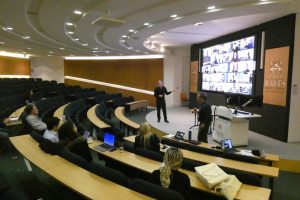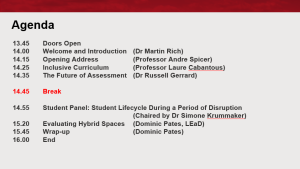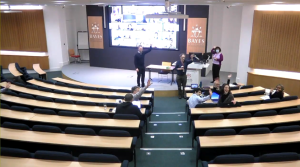The Bayes Teaching and Learning Exchange, a community event to support the sharing of effective teaching practice within the school, has evolved in format since the first one in 2018. Co-hosted by Dr Martin Rich and LEaD, they began as fully in-person events and moved online in the summer of 2020. We are now organising our second hybrid event, on the theme of ‘The New Normal?’. As we prepare to host this next one, here are some reflections on the 8th Exchange, run in March of this year.

Themed around the notion of ‘Disruption’, the event saw around 12 colleagues and presenters join us in the LG001 auditorium at Bunhill Row, and around 60 more join us online via Zoom. We used the Zoom Rooms hybrid lecture system, recently installed as a part of City’s ISLA project, to provide the opportunity for presenters and participants to contribute to the discussions, whether they were joining us in-person in LG001 or online. While we had been encouraging in-person participation alongside the wider institutional drive towards a ‘return to campus’, we purposefully offered staff the option for participating in their preferred mode. It was a little surprising that a far greater proportion had chosen to participate virtually, but instructive for us as event organisers. It also ensured that the Exchange was as accessible as possible – far more so than the initial in-person ones had been.

The new Bayes Dean, Professor Andre Spicer, gave the opening address, encouraging the audience to consider that disruption can offer an opportunity to break out of what he described as ‘the competency trap’.
He was followed by presentations from Dr Russell Gerrard on the future of assessment and Professor Laure Cabantous on the school’s approach to building an inclusive curriculum. Dr Simone Krummaker led a discussion on the student lifecycle with a current Bayes student who had started as an undergraduate at Cass and gone on to become a postgraduate at Bayes, experiencing several different aspects of disruption to her studies. We then invited the audience to take part in a real-time evaluation of LG001 as an example of a hybrid lecture theatre.
A playlist of recordings from the event is available below. Click the forward/back arrows next to the play option (bottom left) to move between session videos.
The 9th Bayes Teaching and Learning Exchange takes place at Bunhill Row and on Zoom on 13th September 2022, between 14:30 – 16:30. If you would like to attend this event, please sign-up using this link.
10 takeaways for running an event in hybrid format
Hosting the 8th Exchange in hybrid format was a huge learning experience, amply demonstrating how key effective planning and preparation was to a successful hybrid event. Below are our top takeaways for running a hybrid event yourself.
- Find out in advance which speakers will be presenting from within the room and who will be presenting online. This might sound obvious but is key to planning how the event will flow and to fully prepare both organisers and presenters. If speakers will be presenting online, consider whether their time zone will differ from the one applying to those in the room.

Dom facilitating the Q&A with Professor Laure Cabantous following their remote presentation - Find out in advance any requirements presenters might have for setting up and delivering their sessions. This might include the requirement to share slides or use a visualiser to show objects to both in-room and online participants, whether the presenter’s camera will be on or not, and whether they will be joined by any colleagues who might need a higher level of access on Zoom to enable them to share content.
- Different types of presentations might need a different camera angle, or for the camera to be zoomed in or out. Work out where to direct the cameras for each presentation. This is even more important if you are working with more than one camera, as we were in LG001.
- Get to know your space in advance (both physical and virtual). Where you can, test for each scenario and make any necessary adjustments to the plan.
- If possible, include an in-room co-pilot to assist with technical requirements including adjusting camera angles and sharing content, and another online to assist the online audience where needed, such as helping with breakout rooms or shared activities, upgrading roles on Zoom, and to report back to the in-room co-pilot if required. Both co-pilots should be aware of the plan for the event and should not have any other duties to allow them to concentrate on their roles.
- Prepare some welcome slides in advance, e.g. agenda, housekeeping rules, and have them on a loop for both in-room and online participants to see. This provides the same set of information to both audiences, helps to establish the terms of engagement and frees you up to focus on ensuring your speakers are ready. It also helps to prevent awkward silences if there are any delays and reassures online participants that they have joined the correct session.

The Agenda slide was one of the welcome slides displayed on screen in LG001 and shared on Zoom at the start of the Exchange - Introduce in-room and remote audiences to each other. For example, this could take the form of an icebreaker activity where a gallery view of online participants is displayed in the room and attendees are encouraged to switch their cameras on, in-person participants turn to the in-room camera and both audiences wave at each other. This has the effect of making both audiences feel they are part of the same event, rather than being two distinct groups of people with no connection to each other.

Dom, Martin, Lisa and other in-room turn to face the camera to greet the Zoom participants at the start of the Exchange - Ensure that the online audience feel included in all activities, including question and answer sessions. Actively invite participation from in-room and online participants. Display the online gallery or thumbnail views to in-room participants where audience interaction is encouraged.
- Make use of spotlighting if your virtual platform enables it (as Zoom does) to focus on whoever is speaking, whether they are in the room or online. This prevents the wrong speaker being displayed within your conferencing platform or on the projection screen.
- Be aware of audio for all participants. Ensure all in-room speakers wear a lapel microphone to provide good sound quality for those online, and that all participants are muted when not speaking. Online participants should mute themselves and if you have an in-room microphone for capturing the audience, it should be muted during remote presentations or participation.
These are our top tips from running this event in a hybrid style. Have you tried running hybrid events yourself? Feel free to share your tips in the comments below.


Thanks Dom and Lisa, very useful and many of these recommendations apply for hybrid teaching too.
Thanks Geraldine. Yes, although we might have had a wider variety of use cases to apply than in a regular teaching session, many of what worked for this event would equally apply for hybrid teaching.
Great post with lots of practical advice! Really appreciate the top tips for running hybrid events. How do you guys run the Q&A aspects – back in the day I used to be a big fan of EVS / PRS 😀 do you vote on multiple-choice answers, can everyone gauge overall sentiments easily whether they’re online or in person?
Thanks Sian, and great to hear from you! We used Poll Everywhere in this particular event – easy to respond whether you’re in the room or online, and thus ideal for hybrid Q&As.